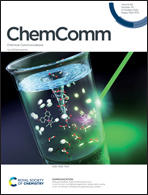Photoswitchable molecular tweezers: isomerization to control substrate binding, and what about vice versa?
Abstract
The linkage of two identical binding motifs by a molecular photoswitch has proven to be a straightforward and versatile strategy to control substrate binding affinity by light. Stimulus control of binding properties in artificial receptors is partly inspired by the dynamic behavior of proteins and is highly attractive as it could, for example, improve extraction processes and allow (de)activation of membrane transport on demand. This feature article summarizes the development and design principles of molecular tweezers containing a molecular photoswitch as the core unit. Besides the control of binding affinity by isomerization, the effect of substrate binding on the isomerization behavior is discussed where data is available. While the latter often receives less attention, it could be of benefit in the future creation of multi-stimuli-controlled molecular switching and machine-like systems.



 Please wait while we load your content...
Please wait while we load your content...